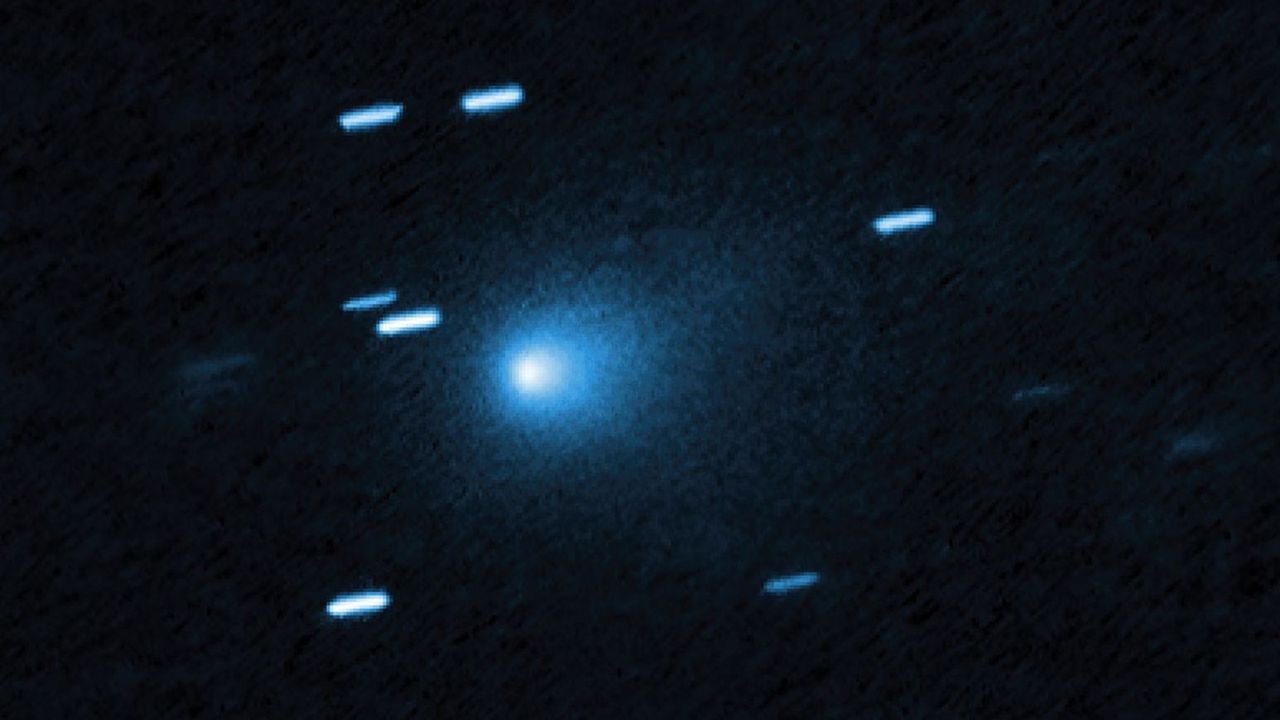Science
Scientists Discover Nickel Vapor in Interstellar Comet 3I/ATLAS

In a significant scientific breakthrough, researchers have detected glowing nickel vapor in the gas surrounding the interstellar comet 3I/ATLAS, challenging existing understandings of chemical processes in space. This discovery marks a critical moment for astrophysics, providing insights into materials originating from beyond our solar system. The findings were made by an international team led by Rohan Rahatgaonkar, a Ph.D. student at the Instituto de Astrofísica-Pontificia Universidad Católica de Chile, alongside Darryl Z. Seligman, an Assistant Professor of Physics and Astronomy at Michigan State University.
On July 1, 2025, the Asteroid Terrestrial-impact Last Alert System (ATLAS) identified 3I/ATLAS as only the third confirmed interstellar object, following the notable discoveries of ‘Oumuamua and comet Borisov. Unlike these previous visitors, 3I/ATLAS was detected early in its approach, allowing scientists a unique opportunity to observe its chemical evolution in real-time as it nears the sun.
Unveiling the Chemical Awakening
The research team utilized the Very Large Telescope (VLT) in Chile, employing advanced spectroscopic techniques to analyze the comet’s atmosphere. Initial observations revealed faint but consistent spectral lines indicative of atomic nickel vapor at a distance of 3.88 astronomical units (AU) from the sun, nearly four times the distance between Earth and the sun. This unexpected discovery of nickel at such a cold distance, where metals typically do not vaporize, suggests that the comet is undergoing a complex chemical activation process.
As the comet approached the sun, the team recorded a surge in nickel vapor emissions. By mid-August 2025, when 3I/ATLAS was approximately 3.07 AU from the sun, they detected the spectral signature of cyanogen (CN) gas, a common emission found in solar system comets. These findings reveal a fascinating pattern of chemical activity that could reshape our understanding of interstellar objects.
Implications for Cosmic Chemistry
The detection of nickel without corresponding levels of iron presents intriguing questions about the processes at play. Traditional models suggest that metals vaporize through sublimation, a process requiring high temperatures. However, the unique chemical signature of 3I/ATLAS indicates that nickel might be released from complex molecules that can disintegrate under sunlight, potentially involving compounds bound to carbon monoxide or other organic materials.
This discovery aligns with data from the James Webb Space Telescope (JWST), which indicated an unusual composition in the comet’s coma, revealing higher levels of carbon dioxide compared to typical solar system comets. The presence of water ice and carbon monoxide also suggests a diverse mixture of frozen materials that are becoming active as the comet approaches the sun.
The ongoing study of 3I/ATLAS not only enhances our understanding of this particular comet but also provides broader insights into the conditions and materials present in distant star systems. By comparing 3I/ATLAS with previous interstellar visitors, scientists aim to gather evidence that could illuminate how planetary systems form across the galaxy.
As 3I/ATLAS continues its journey towards perihelion, or its closest approach to the sun, expected on October 29, 2025, the international research team remains poised to collect further data. They anticipate increased activity and potentially new chemical species emerging as temperatures rise.
The implications of these findings extend beyond the individual comet, touching on fundamental questions about the building blocks of planetary systems. The research underscores the importance of methodical, evidence-based inquiry in unraveling the complexities of the universe.
In conclusion, the unexpected detection of nickel vapor in 3I/ATLAS not only enriches our knowledge of this interstellar wanderer but also ignites curiosity about the materials that populate our cosmos. With continued observations, scientists hope to unlock further secrets of this cosmic messenger before it departs the solar system, carrying its ancient materials back into the vast interstellar void.
-

 Science2 weeks ago
Science2 weeks agoIROS 2025 to Showcase Cutting-Edge Robotics Innovations in China
-

 Politics2 weeks ago
Politics2 weeks agoJudge Considers Dismissal of Chelsea Housing Case Citing AI Flaws
-

 World2 weeks ago
World2 weeks agoBravo Company Veterans Honored with Bronze Medals After 56 Years
-

 Top Stories2 weeks ago
Top Stories2 weeks agoIndonesia Suspends 27,000 Bank Accounts in Online Gambling Crackdown
-

 Lifestyle2 weeks ago
Lifestyle2 weeks agoStone Island’s Logo Worn by Extremists Sparks Brand Dilemma
-

 Sports2 weeks ago
Sports2 weeks agoMel Kiper Jr. Reveals Top 25 Prospects for 2026 NFL Draft
-

 Health2 weeks ago
Health2 weeks agoStartup Liberate Bio Secures $31 Million for Next-Gen Therapies
-

 Health2 weeks ago
Health2 weeks agoTop Hyaluronic Acid Serums for Radiant Skin in 2025
-

 World2 weeks ago
World2 weeks agoHoneywell Predicts Record Demand for Business Jets Over Next Decade
-

 Politics2 weeks ago
Politics2 weeks agoNew Jersey Voters Urged to Register Ahead of November Election
-

 Lifestyle2 weeks ago
Lifestyle2 weeks agoMary Morgan Jackson Crowned Little Miss National Peanut Festival 2025
-

 Sports2 weeks ago
Sports2 weeks agoYamamoto’s Mastery Leads Dodgers to 5-1 Victory in NLCS Game 2







